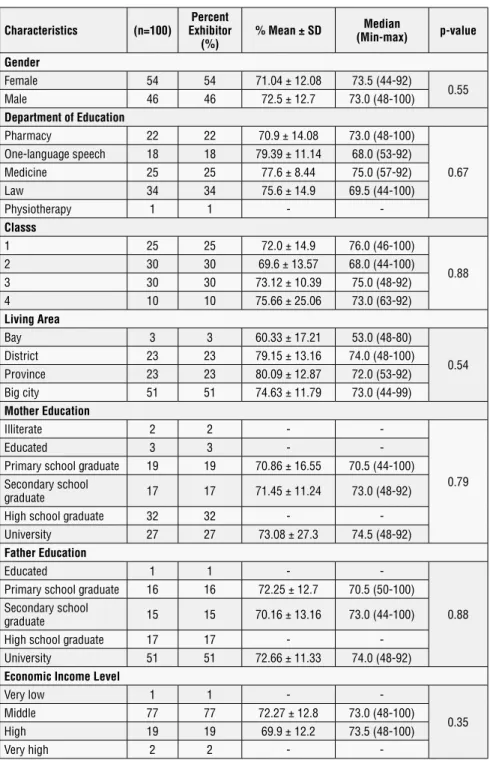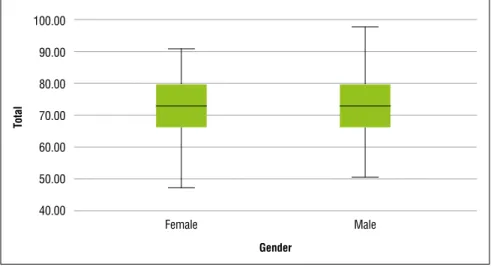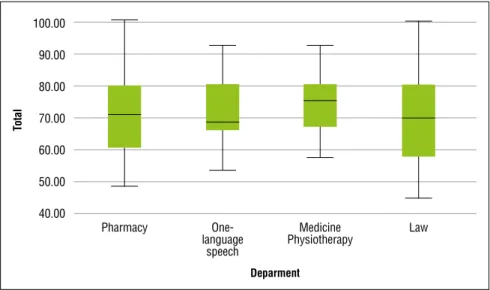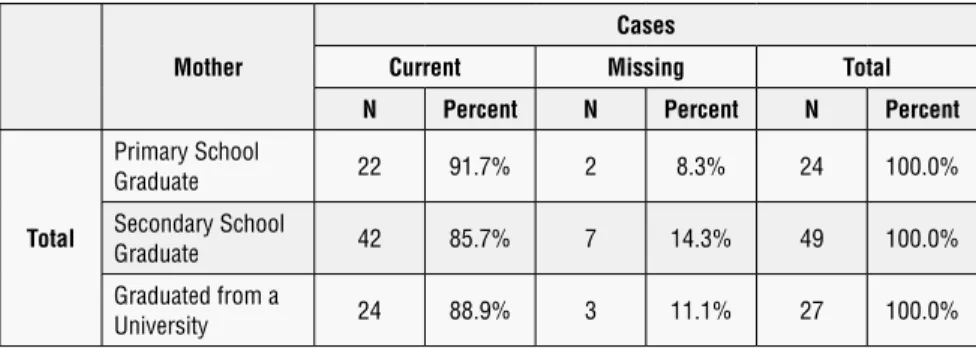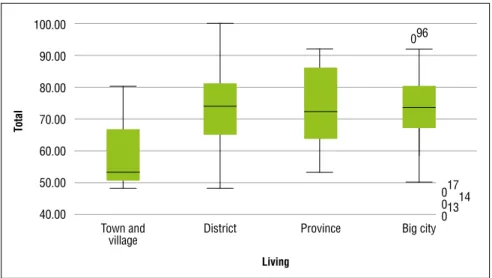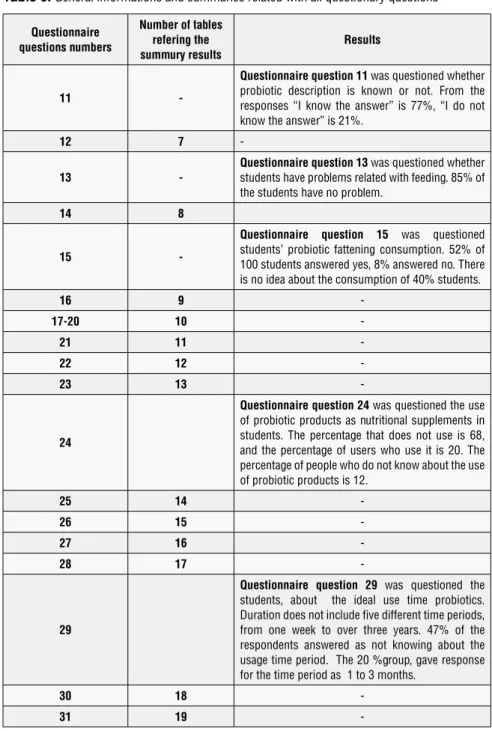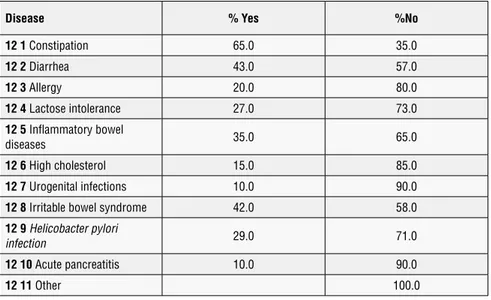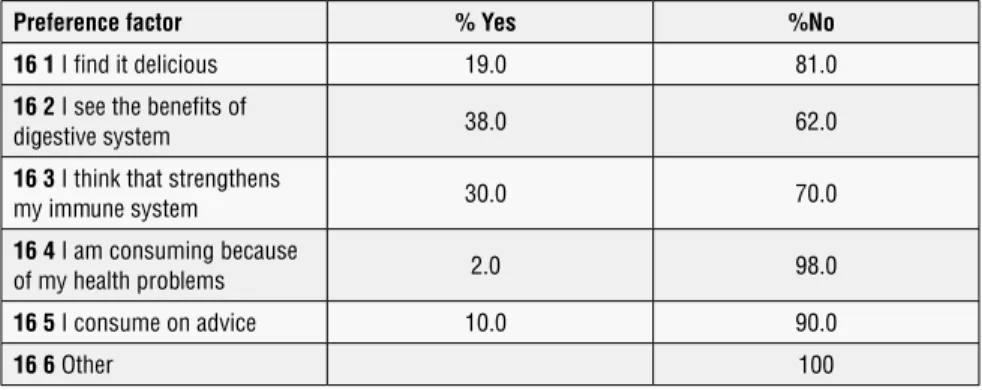Evaluation of Probiotic Use of The Students of
Istanbul Medipol University
Neda Taner1, Eşref Tatlıpınar2*, Nihal Büyükuslu1 1 Istanbul Medipol University, School of Nutrition and Dietetics, Istanbul, Turkey
2 Istanbul Medipol University, School of Pharmacy, Department of Pharmaceutical Toxicology, Istanbul, Turkey
INTRODUCTION
Probiotics are selectable viable microorganisms used as nutritional supplements that contribute to maintaining human health or have potential benefits for dis-ease prevention. 1 On the other hand, prebiotics, are defined as food components that stimulate the reproduction and activity of beneficial bacteria in the colon, thereby indirectly cause benefit to the host. 2 Symbiotics are also non-digestible substances that activate or strengthen the effect of probiotic bacteria with the po-ABSTRACT
This research; is planned to determine the level of knowledge about probiotic nutri-tions and, the consumption of them by university students. The date range of the study was 2018. A total of 100 students were surveyed at the İstanbul Medipol University, 47 men and 53 women aged 18-30 years. General information and demographic status of participants were questioned. Also, height and weight data were recorded by their written notifications. In parallel with the ever-increasing work on the positive effects of probiotics on health; increased consumption of probiotics and increased knowledge. Microorganisms can directly or indirectly cause the formation of many diseases. 20% of the students consume these nutrients on the recommendation; and 24% of them did not consume it because they think did not need it. Although probiotic dairy products are mostly used for symptoms of constipation, there is not enough information in the context of other diseases.
Keywords: Microflora, probiotic nutrient, fermentation
Corresponding Author: e-mail: metatlipinar@medipol.edu.tr ORCID Neda Taner: 0000-0002-6141-8676 Eşref Tatlıpınar: 0000-0001-8422-3188 Nihal Büyükuslu: 0000-0003-1420-0989
(Received 13 December 2020, accepted 06 March 2020) Acta Pharm. Sci. Vol 59:(1), 2021
tential synergistic effect caused by the combination of probiotics and prebiotics. 3 The history of the relationship between gut health and human disease has fol-lowed a development from Hippocrates (460-370 BC) to the present day. With-in the understandWith-ing of modern medicWith-ine, the first studies related to With-intestWith-inal bacteria and digestive physiology, which started with T. Escherich in 1886, has become a common scientific knowledge field including prebiotic, probiotic and symbiotic definitions that form today’s common terminology. 4,5
Functional foods are food itself and, additive ingredients, that provide the human body’s need for essential nutrients, provide additional benefits in human physi-ology and metabolic functions, thereby helping to prevent disease and achieve a healthier life. 6 On the other hand, these foods are also defined as nutrients that
can be consumed in the form of nutriment with a daily diet, without containing synthetic compounds and have health and well-being properties. 7
With the development of healthy eating awareness, consumers expect to benefit from health benefits as well as food. Functional foods have become one of the fastest growing sectors of the food industry as a result of these expectations that consumers show to new products and quality. One of these functional foods is probiotics that have received great interest in recent years. As of the definition given above probiotic bacteria are found in the normal human intestinal flora. Probiotics are naturally present in fermented milk and other fermented foods, but many products originating from yoghurt, sour cream, milk powder, sweets, fruit juice, ice cream, baby milk or butter, butter, mayonnaise, meat and oats can also be added externally.6
One of the questions most asked by consumers who see a balanced intestinal flora in relation to an effective immune system is the benefit of probiotic use on healthy people. A response to a healthy microflora composition and the benefits to the host is usually that the answer is that it can prevent complaints that may arise from occasional imbalances, even if they are speculative, even in a balanced system. On the other hand, probiotics have been proven to have effects such as gastrointestinal complaints, normalization of reduced bowel mobility or
reduc-constipation, preventing inflammation, colonization of the intestinal flora, and prevention of colonization of pathogenic bacteria in the intestine.9
This research is to investigate the structure and properties of probiotics, their effects on human health, their usage areas, their effect mechanisms and their reliability in order to reach the desired point by determining information about university students’ consumption of probiotic foods and probiotics which are in-creasingly used nowadays.
METHODOLOGY
This section comprises the methods and tools used in the research and defined in sub-headings as of ‘Research Model’, ‘Research Universe and Sampling’, ‘Data Collection Techniques’ and ‘Analysis of Data’.
Research Model
The screening model was used in this study. The research aimed to determine the probiotic nutrient consumption status, probiotic consumption frequency and information about probiotic foods of the students who continue university educa-tion.
Research Universe and Sampling
The universe of this research was Istanbul Medipol University. The questionnaire was applied to 100 students selected randomly among the students who contin-ued their education at Istanbul Medipol University.
Data Collection Techniques
The research data were collected by the researcher with the questionnaire tech-nique. The survey form developed as a data collection tool is preferred because it is the most appropriate tool in the data collection. The evaluation and prepara-tion of the quesprepara-tionnaire were consisting of literature expert opinions and the examinations and review of thesis and researches related with the subject. The questionnaire consists of three parts. In the first part, it is aimed to measure the information about the students and their families, in the second part the pro-biotic food consumption situation and in the third part the information about the probiotic products.
The questionnaire was applied to the students participating in the research under the supervision of the researcher. The necessary explanations about the question-naire were made to the students by the researcers and, it was accepted that the students who participated in the research gave accurate and impartial answers to the questions.
Analaysis of Data
The data collected about the sub-problems that are searched for within the frame-work of the research problem are first processed in the data coding tables on the computer. Then statistical analyzes on the data were performed using SPSS (Sta-tistical PacketforSocialSciences) 20 package program.
Findings are shown in the tables as female and male gender, number and per-centage. Frequency (f), percent (%), chi square, arithmetic mean (x) and standard deviation (ss) were used to determine the personal and family characteristics of the students. A significance level of 0.05 was taken to test the differences. The following formula was used in the calculation of the BMI of the students in the study, and the evaluations were made according to the following classifications.
BMI = (Body Weight (kg)) / (Thickness (m2))
• BMI below 18.5 Underweight
• 18.5- 24.9 Normal Weight
• 25.0- 29.9 Excess Weight
• 30.0- 39.9 Obese
• Morbid (serious) obesity Over 40,0 °
RESULTS AND DISCUSSION
Participants selected through coincidental sampling are students from the Medipol University who responded to the survey. Demographic data and values for these students and their families were first collected for measurement results of knowledge of probiotic food consumption and probiotic products of research and thesis subjects. The results are summarized in Table 1 below.
Findings / Part 1. Participatory demographic data
Demographic data and values of the participants: General
fami-Table 1 . Participants’ demographic data and values
Characteristics (n=100) Exhibitor Percent
(%) % Mean ± SD Median (Min-max) p-value Gender Female 54 54 71.04 ± 12.08 73.5 (44-92) 0.55 Male 46 46 72.5 ± 12.7 73.0 (48-100) Department of Education Pharmacy 22 22 70.9 ± 14.08 73.0 (48-100) 0.67 One-language speech 18 18 79.39 ± 11.14 68.0 (53-92) Medicine 25 25 77.6 ± 8.44 75.0 (57-92) Law 34 34 75.6 ± 14.9 69.5 (44-100) Physiotherapy 1 1 - -Classs 1 25 25 72.0 ± 14.9 76.0 (46-100) 0.88 2 30 30 69.6 ± 13.57 68.0 (44-100) 3 30 30 73.12 ± 10.39 75.0 (48-92) 4 10 10 75.66 ± 25.06 73.0 (63-92) Living Area Bay 3 3 60.33 ± 17.21 53.0 (48-80) 0.54 District 23 23 79.15 ± 13.16 74.0 (48-100) Province 23 23 80.09 ± 12.87 72.0 (53-92) Big city 51 51 74.63 ± 11.79 73.0 (44-99) Mother Education Illiterate 2 2 - -0.79 Educated 3 3 -
-Primary school graduate 19 19 70.86 ± 16.55 70.5 (44-100)
Secondary school
graduate 17 17 71.45 ± 11.24 73.0 (48-92)
High school graduate 32 32 -
-University 27 27 73.08 ± 27.3 74.5 (48-92)
Father Education
Educated 1 1 -
-0.88
Primary school graduate 16 16 72.25 ± 12.7 70.5 (50-100)
Secondary school
graduate 15 15 70.16 ± 13.16 73.0 (44-100)
High school graduate 17 17 -
-University 51 51 72.66 ± 11.33 74.0 (48-92)
Economic Income Level
Very low 1 1 -
-0.35
Middle 77 77 72.27 ± 12.8 73.0 (48-100)
High 19 19 69.9 ± 12.2 73.5 (48-100)
Very high 2 2 -
-Participants’ mean height (170.4 ± 14.08) in terms of arithmetic mean ± SD (Std.) body weight (66.45 ± 14.8) and ages (21.35 ± 3.25)
Demographic data and values of the participants: Participant gender differentiation
The values for the data table are also summarized in the figures below. Figure 1 shows the status of the participants in terms of gender differentiation. Total mean values of both sexes (71.04 ± 12.08) (72.50 ± 12.7) p> 0.05 in both males and females, respectively, show no statistically significant difference.
Gender Female Male 100.00 90.00 80.00 70.00 60.00 50.00 40.00 Total
Figure 1 . Participant gender differentiation
Demographic data and values of participants: Differences in occupa-tional section preferences of participants
Figure 2 exhibit the training sections preferred by the participants. Participants have a more widespread preference in the field of pharmacy and law, while a lan-guage preference in speech and medicine-physics is relatively less favorable than the other two disciplines. However, there is no statistically significant difference between all departmental preferences.
Deparment Pharmacy One-language speech Medicine Physiotherapy Law 100.00 90.00 80.00 70.00 60.00 50.00 40.00 Total
Figure 2 . Participants’ preference for occupational sections
Demographic data and values of participants:
Difference in educational level of participant parents
The results of the differences in educational level of participant parents were ex-hibited in Table 2, Figure 3 and, Table 3, Figure 4, as of the data of fathers and mothers, respectively. There is a wide range in terms of different graduation cat-egories, but no statistical significance is calculated.
Educational level of fathers: Table 2 . Father: Case Summary
Father Cases Current Missing Total Current Missing Total Current Missing Total
N Percent N Percent N Percent
Total Primary School Graduate 16 94.1% 1 5.9% 17 100.0% Secondary School Graduate 29 90.6% 3 9.4% 32 100.0% Graduated from a University 43 84.3% 8 15.7% 51 100.0%
Father Primary school grduate Secondary school grduate Grduated fram a Universty 100.00 90.00 80.00 70.00 60.00 50.00 40.00 Total
Figure 3 . Difference in educational level of participant parents (father)
Educational level of mothers: Table 3 . Mother: Case Summary
Mother
Cases
Current Missing Total
N Percent N Percent N Percent
Total Primary School Graduate 22 91.7% 2 8.3% 24 100.0% Secondary School Graduate 42 85.7% 7 14.3% 49 100.0% Graduated from a University 24 88.9% 3 11.1% 27 100.0%
Father Primary school grduate Secondary school grduate Grduated fram a Universty 100.00 90.00 80.00 70.00 60.00 50.00 40.00 Total
Figure 4 . Difference in educational level of participant parents (mother)
Demographic data and values of participants:
Differences in economic income level of participant families
The level of income of the participating families is shown in table 4 and figure 5. In terms of income levels, participants are from low, middle income families. However, there is no statistical difference between these groups.
Table 4 . What do you think? Economic Level: Case Study Summary
What do you think? -Economic Level
Cases
Current Missing Total
N Percent N Percent N Percent
Total Low and Medium 68 87.2% 10 12.8% 78 100.0%
What do you think? / economic level
Low and medium High
100.00 90.00 80.00 70.00 60.00 50.00 40.00 Total
Figure 5 . Differences in economic income level of participant families
Participants’ demographic data and values: Life zones
Participants’ families prefer to live in the cities. However, there is no statistical difference among the participants from the smaller settlement areas.
Table 5 . Life: Case Summary
Life
Cases
Current Missing Total
N Percent N Percent N Percent
Total
Town and village 3 100.0% 0 0.0% 3 100.0%
District 22 95.7% 1 4.3% 23 100.0%
Province 17 73.9% 6 26.1% 23 100.0%
Living Town and
village District Province
096 100.00 90.00 80.00 70.00 60.00 50.00 40.00 Total 017 0 14 013 Big city
Figure 6 . Living area preferences of participating families
Findings / Part 2. Measurement of students’ knowledge of probiotic food consumption and probiotic products
This section is based on the answers obtained from questionnaire questions 11-31. Table 6 summurizes the general information related with all questionarry questions.
Table 6 . General informations and summaries related with all questionary questions Questionnaire questions numbers Number of tables refering the summury results Results 11
-Questionnaire question 11 was questioned whether probiotic description is known or not. From the responses “I know the answer” is 77%, “I do not know the answer” is 21%.
12 7
-13
-Questionnaire question 13 was questioned whether students have problems related with feeding. 85% of the students have no problem.
14 8
15
-Questionnaire question 15 was questioned students’ probiotic fattening consumption. 52% of 100 students answered yes, 8% answered no. There is no idea about the consumption of 40% students.
16 9 -17-20 10 -21 11 -22 12 -23 13 -24
Questionnaire question 24 was questioned the use of probiotic products as nutritional supplements in students. The percentage that does not use is 68, and the percentage of users who use it is 20. The percentage of people who do not know about the use of probiotic products is 12. 25 14 -26 15 -27 16 -28 17 -29
Questionnaire question 29 was questioned the students, about the ideal use time probiotics. Duration does not include five different time periods, from one week to over three years. 47% of the
Questionnaire question 12:
This questionnaire question mainly questioned whether the disease (s) benefit or not from probiotic food consumption. Mainly the section measures information in 11 categories including constipation, diarrhea, allergy, lactose intolerance, in-flammatory bowel diseases, high cholesterol, urogenital infections, irritable bow-el syndrome, hbow-elicobacter pylori infection, acute pancreatitis and others. These are summarized in the table 7 below.
Table 7 . Questionnaire Question 12: Which disease (s) do you think benefit from probiotic
food consumption?
Disease % Yes %No
12 1 Constipation 65.0 35.0 12 2 Diarrhea 43.0 57.0 12 3 Allergy 20.0 80.0 12 4 Lactose intolerance 27.0 73.0 12 5 Inflammatory bowel diseases 35.0 65.0 12 6 High cholesterol 15.0 85.0 12 7 Urogenital infections 10.0 90.0
12 8 Irritable bowel syndrome 42.0 58.0
12 9 Helicobacter pylori
infection 29.0 71.0
12 10 Acute pancreatitis 10.0 90.0
12 11 Other 100.0
Yes answers indicate that students have knowledge only about constipation, without consisting of sufficient information of probiotics usage in other diseases.
Questionnaire question 14:
In questionnaire question 14, it is questioned whether and if there were any dis-eases diagnosed in the students. The answers to this question are summarized in table 8.
Table 8. Questionnaire Question 14: If you have a diagnosed any health problem.
Disease % Yes %No
14 1 Diabetes 4.0 96.0 14 2 Kidney disease 2.0 98.0 14 3 Dental problems 1.0 99.0 14 4 Anemia 8.0 92.0 14 5 Eye illness 6.0 94.0 14 6 Cardiovascular disease 1.0 99.0 14 7 Other 9.0 91.0 Questionnaire question 16:
This questionnaire question, questioned the students’ reasons for consuming probiotic food. Belowmentioned table 9 summarizes the answers.
Table 9 . Questionnaire Question 16: What are your reasons / reasons for consuming probiotic
food?
Preference factor % Yes %No
16 1 I find it delicious 19.0 81.0
16 2 I see the benefits of
digestive system 38.0 62.0
16 3 I think that strengthens
my immune system 30.0 70.0 16 4 I am consuming because of my health problems 2.0 98.0 16 5 I consume on advice 10.0 90.0 16 6 Other 100 Questionnaire question 17-20:
The answers given by the students to the questions 17-20 of the
Table 10 . Questionnaire Question 17-20 Answers
Question % No Idea % Yes % No
Questionnaire Question 17. Do you see the
benefit of the probiotic foods you use? 41 53 6
Survey Question 18. Do you read the
packa-ging labels of the probiotic foods you bought? 40 45 15
Questionnaire Question 19. Do you know the microorganisms in the probiotic foods you
consume? 40 30 30
Questionnaire Question 20. Are you proposing
for the consumption of probiotic foods? 39 38 23
Questionnaire question 21:
It is questioned that which health problems contributed to the consumption of probiotic nutrients. The returns from the students are summarized in the below-mentioned.table 11.
Table 11 . Questionnaire Question 21: Do you think that the consumption of probiotic food
contributes to the elimination of the following health problem/problems?
Problems %Yes %No
21 1 Circulatory system
problems 6.0 94.0
21 2 Digestive system problems 51.0 49.0
21 3 Immune system problems 36.0 64.0
21 4 Obesity 16.0 84.0
21 5 Other 2.0 98.0
Questionnaire question 22:
In this question, students were questioned about the reasons of why they do not consume probiotic foods. In table 12, relevent “yes” or “no” responses as tabu-lated below.
Table 12 . Questionnaire Question 22: What are your reasons / reasons for not consuming
probiotic foods? Causes % Yes % No 22 1 Do not know 17.0 83.0 22 2 Not needing 24.0 76.0 22 3 Expensive find 12.0 88.0 22 4 No tasteless find 10.0 90.0 22 5 Other 6.0 94.0
Questionnaire 23 questions:
Students’ were questioned of their probiotic food consumption frequency. Pro-biotic yoghurt takes the first order of 2-3 times a week and consumes 26% from eleven different products. Table 13 summarizes the situation.
Table 13 . Questionnaire Question 23: Consumption frequency of probiotic foods in students Food consumption frequency
Food 0 Everyday 2-3 times a week 1 time per week Once in a month I do not consume 23 1 Probiotic yogurt 12.0 15.0 26.0 17.0 10.0 20.0 23 2 Probiotic milk 13.0 3.0 15.0 15.0 14.0 40.0 23 3 Kefir 12.0 1.0 5.0 9.0 16.0 57.0 23 4 Kefir cheese 15.0 1.0 2.0 1.0 7.0 74.0
23 5 Bread with sourdough yeast 16.0 7.0 2.0 10.0 17.0 48.0
23 6 Tarhana 10.0 3.0 22.0 24.0 32.0 9.0
23 7 Boza 14.0 - 3.0 4.0 24.0 55.0
23 8 Redfish 15.0 - 1.0 - 1.0 83.0
23 9 Kambucha tea 16.0 1.0 1.0 2.0 - 80.0
23 10 Natural turnip juice 11.0 3.0 5.0 10.0 30.0 41.0
23 11 Pickled olives 13.0 15.0 16.0 9.0 15.0 32.0
Questionnaire 25 questions:
Survey question 25, investigated the reasons of students’ supplement.consump-tions. The tendency to consume the most important product among the four ele-ments is the recommendation (15%) taken around. Table 14 exhibits the collec-tive results.
Table 14 . Questionnaire Question 25: What is the reason for consuming a supplementary
probiotic product?
Causes % Yes % No
Questionnaire 26 questions:
This questionnaire question 26, examined how the students hear of about the supplementary probiotic products. Among the six different learning sources, “friends, acquaintances, family and similar factors” is more prominent than oth-ers. Table 15 summarizes the results of this case
Table 15 . Question 26: Where did you hear about the supplementary probiotic products?
Resources % Yes % No
26 1 Specialist (doctor, pharmacist or dietitian) 9.0 91.0
26 2 Friends, acquaintances, family etc. 11.0 89.0
26 3 Advertisements (newspapers, magazines,
television) 6.0 94.0
26 4 Education, conferences, informal meetings 5.0 95.0
26 5 Pharmacies and sales points 6.0 94.0
26 6 Internet 6.0 94.0
Questionnaire 27 questions:
Questionnaire question 27, questioned the determination of the criteria why stu-dents took into account when purchasing supplemental probiotic products. Ac-cording to five different criteria, the preference factor of the students in purchas-ing tendency is the content of the product (20%) and table 16 summarizes the results for this parameter.
Table 16 . Questionnaire Question 27: What are the criteria / criteria to consider when buying
a supplementary probiotic product?
Criteria %Yes %No
27 1 Price 4.0 96.0
27 2 Brand 9.0 91.0
27 3 Contents 20.0 79.0
27 4 Recommendation 6.0 94.0
Questionnaire 28 questions:
The questionnaire question 28, questioned which 28 students used the sup-plementary probiotic products as brands. Table 17 summarizes the results and points out that Enterogermina (13%) is the most preferred product.
Table 17 . Questionnaire Question 28: Which one do you use as a supplementary probiotic
product?
Probiotic products % Yes % No
28 1 NBL Probiotic Goldschafts 3.0 97.0
28 2 Enterogermina® 13.0 87.0
28 3 BIFIFORM® Drops 3.0 97.0
28 4 NTBIOTIC Capsule - 100.0
28 5 Natrol Acidophilus Capsule - 100.0
28 6 Other 5.0 95.0
Questionnaire 30 questions:
The questionnaire question 30, questioned about the participating students how they recognize the sources of information about probiotics. It is found that, the first order tendency is to acquire information through 61% of health personnel. The answers were documented below in table 18.
Table 18 . Survey Question 30: Which do you see as a source of information about probiotics?
A source of information on probiotics % Yes % No
30 1 Internet 36.0 64.0
30 2 Written-visual media 24.0 76.0
30 3 Through my friend 7.0 93.0
30 4 Through the health personnel 61.0 39.0
30 5 Medical courses 21.0 79.0
Questionnaire 31 questions:
The most comprehensive questionnaire surveyed among participant students in the questionnaire was Question 31, and it analyzes 20 sub parameters of “How
Table 19 . Survey Question 31: How do you think reinforcing probiotic products are affecting our health? I strong ly disa gree I do not a gree Partially Ag ree I a gree Absolutely I a gree
31 1 It contains useful items in health. 2.0 2.0 20.0 36.0 26.0 31 2 Helps strengthen the immune system. 7.0 13.0 41.0 25.0 -31 3 Does not affect the regulation of the digestive
system. 37.0 38.0 2.0 5.0 3.0
31 4 Contains a high number of microorganisms. 2.0 3.0 26.0 37.0 16.0 31 5 Prevents milk-induced discomfort (lactose
intolerance). 4.0 8.0 31.0 20.0 13.0
31 6 Supports bone development. 2.0 8.0 15.0 29.0 30.0
31 7 There is no therapeutic effect. 23.0 31.0 21.0 4.0 7.0 31 8 It facilitates digestion by accelerating the
transit of consumed foods. 4.0 10.0 13.0 35.0 21.0
31 9 Causes cancer. 42.0 34.0 6.0 5.0 1.0
31 10 Prevents disease-causing microorganisms
from setting in the gut 5.0 6.0 23.0 29.0 24.0
31 11 Antibiotic-induced diarrhea is good. 1.0 7.0 28.0 28.0 20.0
31 12 Causes allergic diseases. 21.0 29.0 21.0 10.0 5.0
31 13 Allows living microorganisms to remain in
balance in the mouth cavity. 6.0 8.0 33.0 23.0 15.0
31 14 Helps to lose weight. 8.0 14.0 36.0 22.0 8.0
31 15 Provides the synthesis of vitamins (B12,
Folic acid). 4.0 8.0 32.0 24.0 16.0
31 16 Supports bone growth by increasing calcium
absorption in the intestines. 3.0 4.0 27.0 31.0 18.0
31 17 Affects oral and dental health negatively. 34.0 29.0 10.0 5.0 5.0 31 18 Organizes intestinal functions in old age. 3.0 5.0 16.0 39.0 24.0 31 19 It is not safe to use probiotic-added foods in
children. 15.0 38.0 16.0 9.0 7.0
31 20 The living organisms living in the intestines
ensure that the microorganisms are in balance. 11.0 17.0 38.0 20.0 100.0
Probiotics are defined as live microorganisms that improve health by promoting health when they are taken in defined quantities. Many of these are obtained by fermentation of dairy products. Lactobacillus and Bifidobacterium are the most frequently found bacteria.10
The use of probiotic dairy products is increasing rapidly in developed countries. The widespread use of such products has great importance in terms of commu-nity health. Increasing consumption especially during childhood will contribute to healthier growth of new generations.
The main reason behind the wide use of prebiotics and probiotics is that many diseases are directly or indirectly related to the impairment of the balance of mi-crobial flora and, that mimi-crobial flora controls this balance of prebiotics and pro-biotics. Particularly, if the side effects are negligible, the greatest advantages can be considered.8
The use of antibiotics, immunosuppressive agents and radiation for the treat-ment of infectious diseases can cause changes in the present balance by affecting the host flora. For this reason, the use of probiotics as an ecological method for the prevention and treatment of diseases has been an interesting research area for scientists.11
While the therapeutic effects and areas of the usage mentioned for probiotics, do not apply to all probiotics, the right microorganism and correct selection of strains is crucial so that the expected effect can be observed. 12 Therefore, it is very
valuable to determine which indications the probioty is acting on, and more im-portantly, to select the optimum strain to obtain the maximum benefit, in other words, to select the ideal probiotic for each disease and disorder.13
Although they support human health with these positive effects, probiotics are not drugs taken to improve health. When the consumption of probiotic foods is stopped, the intestinal flora returns to its original state and the positive effect is lifted. For this reason, probiotics are only microorganisms that have positive ef-fects when they are taken in the body regularly with probiotic foods. The positive health effects of probiotic foods can only be observed by cultivating acid-resistant probiotic bacteria in culture, using the cultures selected from pure cultures, and consuming the products for a long time without interruption.3
often preferred to daily nutrition. Nutrient or any component should not have the ability to be used as a medicine. The functional component in foods should be resistant to digestion and should not show any health-affecting properties when taken over daily recommended amounts.
Much of the positive effects of prebiotics and probiotics studies have not yet been proven and the mechanism of action of proven efficacy has not been determined precisely. 14 Therefore, it may be useful to clarify the issues such as precise
in-dications, mechanisms underlying the effect, determination of correct strains, selection of suitable host-microorganism-related prebiotic and, establishment of appropriate symbiotic combinations by making more randomized controlled studies related to this important topic.
The following table is important as a result of this thesis work.
Table 20 . Measurement of knowledge of probiotic food consumption and probiotic products
by participating students
Survey QUESTION Parameter % Yes
Questionnaire Question 12: Which disease (s) do you
think probiotic food consumption might benefit? 12 1 Constipation 65.0
Questionnaire Question 14: If you have a diagnosed
health problem: 14 4 Anemia 8.0
Questionnaire Question 16: What are your reasons / reasons for consuming probiotic food?
16 2 I see the benefits of digestive
system 38.0
Questionnaire Question 17: Do you see the benefit of
the probiotic foods you use? 53
Questionnaire Question 18: Do you read the packaging
labels of the probiotic foods you bought? 45
Questionnaire Question 19: Do you know the
microorganisms in the probiotic foods you consume? 30
Questionnaire Question 20: Are you proposing for the
consumption of probiotic foods? 38
Questionnaire Question 21: Do you think that consumption of probiotic food contributes to the elimination of the following health problem / problems?
21 2 Digestive
system problems 51.0
Questionnaire Question 22: What are your reasons /
reasons for not consuming probiotic foods? 22 2 Not needing 24.0
Questionnaire Question 23: Consumption frequency of
probiotic foods in students 23.1 Probiotic yogurt 26.0 (2-3 times a week)
Questionnaire Question 25: What is the reason for
consuming a supplementary probiotic product? 25 1 Health problems 8.0
Questionnaire Question 26: Where did you hear about the supplementary probiotic products?
26 2 Friends, acquaintances,
Questionnaire Question 27: What are the criteria / criteria to consider when purchasing a supplementary
probiotic product? 27 3 Contents 20.0
Questionnaire Question 28: Which one do you use as a
supplementary probiotic product? 28 2 Enterogermina® 13.0
Questionnaire Question 29: Optimal use of probiotics 1-3 months 20 Questionnaire Question 30: Which do you see as a
source of information on probiotics? 30 4 Through the health personnel 61.0
Questionnaire Question 31: How do you think reinforcing probiotic products have an impact on our health?
I agree + I absolutely agree 31 20 The living
organisms living in the intestines ensure that the microorganisms are in balance.
20+100
In the context of the above table results, this study presents a summary of the cross-sectional results of the questionnaire on the measurement of knowledge of probiotic food consumption and probiotic products of participating students. These results are of great importance in support of the literature on probiotic consciousness, relevance and use discussed above.
As a result, probiotic foods, which have numerous benefits in terms of health protection and positive development, do not attract as much interest in the con-sumer diet. The underlying reason for this is that probiotic foods are more ex-pensive than those produced by conventional methods. Productivity to probiotic appetite and its addition to the diet are only due to the full knowledge of the posi-tive effects of these foods on health. It should be considered that probiotic foods are not medicines and should not be discontinued when consumed, otherwise the intestinal flora will soon return to its former state.
REFERENCES
1. Ali, A. A., Velasquez, M. T., Hansen, C. T., Mohamed, A. I. & Bhathena, S. J. (2004). Effects of soybean isoflavones, probiotics, and their interactions on lipid metabolism and endocrine sys-tem in an animal model of obesity and diabetes, J. Nutr. Biochem. 15, 583–590, doi: 10.1016/j. jnutbio.2004.04.005.
2. Bertelsen, R. J., Jensen, E. T. & Ringel-kulka, T. (2016). Use of probiotics and prebiotics in infant feeding. Best Pract. Res. Clin. Gastroenterol. 30, 39-48, doi: 10.1016/j.bpg.2016.01.001. 3. Vrese, M. De. & Schrezenmeir, J. (2008). Probiotics, Prebiotics, and Synbiotics, Adv. Bio-chem. Eng. Biotechnol. 111, 1–66, doi: 10.1007/10_2008_097.
4. Mizock, B. A. (2015). Probiotics, Dis. Mon. 61, 259–290, doi: 10.1016/j.disamonth.2015.03.011. 5. Al-sheraji, S. H., Ismail, A., Yazid, M. & Mustafa, S. (2013). Prebiotics as functional foods: A review. J. Funct. Foods, 5, 1542–1553, doi: 10.1016/j.jff.2013.08.009.
6. Gülbandilar, A. (2017). Fonksiyonel Gıda Olarak Kullanılan Probiyotikler ve Özellikleri. Tur. J. Sci. Rev. 10, 44–47.
7. Erba, M., Birle, A. & Birli, A. (2006). Yeni Bir Gıda Grubu Olarak Fonksiyonel Gıdalar. Türkiye 9. Gıda Kongresi; 24-26 Mayıs 2006. 1, 791–794.
8. Daniel, C., Pot, B. & Foligne, B. (2013). Probiotics from research to market: the possibilities, risks and challenges. Curr. Opin. Microbiol. 16, 284-292, doi: 10.1016/j.mib.2013.06.008. 9. Kanamori, Y., Sugiyama, M., Hashizume, K., Yuki, N., Morotomi, M. & Tanaka, R. (2004). Experience of long-term synbiotic therapy in seven short bowel patients with refractory entero-colitis. J. Pediatr. Surg. 39, 1686–1692, doi: 10.1016/j.jpedsurg.2004.07.013.
10. Sanders, M. E., Gibson, G. R., Gill, H. S. & Guarner, F. (2007). Probiotics : Their Potential to Impact Human Health. 36.
11. Markowiak, P. & Śliżewska, K. (2017). Effects of Probiotics, Prebiotics, and Synbiotics on Human Health. Nutrients, 9, 1021, doi: 10.3390/nu9091021.
12. Pinn, D. M., Aroniadis, O. C. & Brandt, L. J. (2015). Is fecal microbiota transplantation (FMT) an effective treatment for patients with functional gastrointestinal disorders (FGID)? Neurogas-troenterol. Motil. 27, 19–29, doi: 10.1111/nmo.12479.
13. Bertazzoni, E., Donelli, G., Midtvedt, T., Nicoli, J. & Sanz, Y. (2013). Probiotics and clini-cal effects : is the number what Probiotics and cliniclini-cal effects : is the number what counts ?, J. Chemotherapy, 25, 193-212, doi: 10.1179/1973947813Y.0000000078.
14. Patel, R. & Dupont, H. L. (2015). New approaches for bacteriotherapy: Prebiotics, new-gener-ation probiotics, and synbiotics. Clin. Infect. Dis. 60, S108–S121, doi: 10.1093/cid/civ177.
